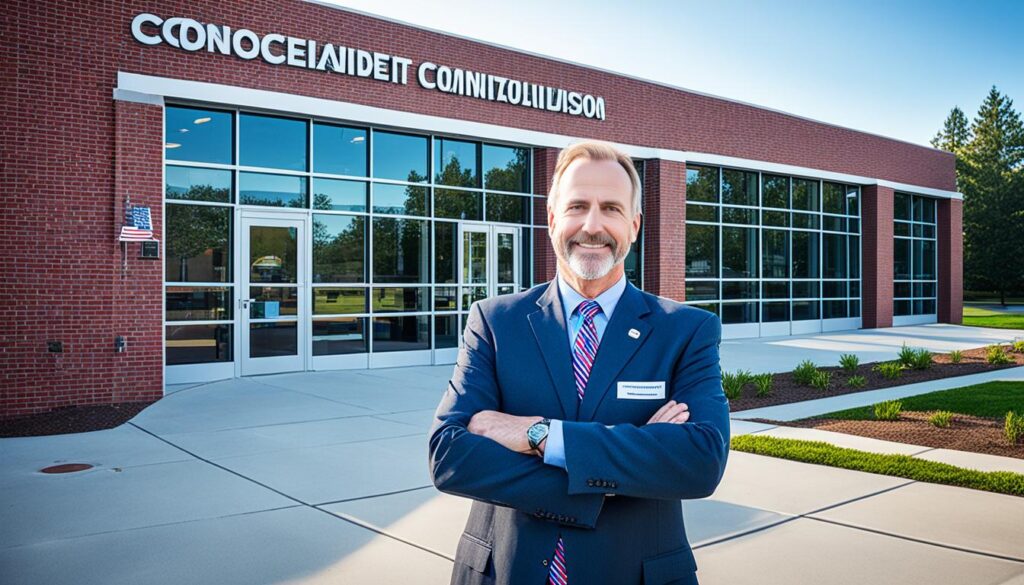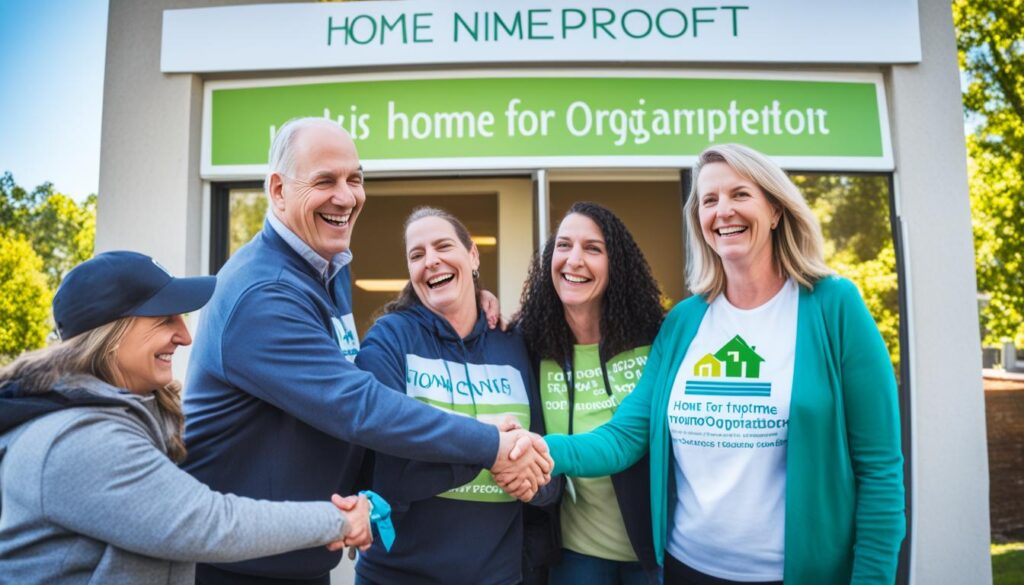Last Updated on: 4th May 2024, 01:39 pm
Understanding the nuances of non profit organization real estate ownership is essential as Real Estate presents not just a base of operations but also a strategic asset for many organizations. Surpassing the common misconception, nonprofits, encompassing well over 90% of all tax-exempt organizations, possess the legal capability to own property as a non profit1. Nonprofit entities, distinct from for-profit corporations that have shareholders as owners, are unique in that they do not issue stock and are barred from distributing profits to individuals1. These provisions ensure that owning property as a non profit aligns with the fundamental principle of serving the public interest without private inurement1.
Key Takeaways
- A non profit can legally own real estate, aiding in mission stabilization and long-term viability.
- Nonprofits represent the majority in the spectrum of tax-exempt organizations and operate under different rules than for-profit entities.
- Real estate ownership for non profits excludes the declaration of stock or distribution of private profits.
- Upon dissolution, a nonprofit’s assets must be allocated to another tax-exempt organization, ensuring continuity in service to the public.
- Understanding the key differences and regulations surrounding non profit real estate ownership is crucial for compliance and strategic planning.
- Successfully managing real estate aids non profits in strengthening their community presence and operational stability.
Understanding Nonprofit Real Estate Ownership
The concept of real estate ownership for non profits encompasses not only acquiring but also managing various property types critical to their operation and mission fulfillment. Navigating the complexities of non profit property ownership laws is essential for these entities to harness the full potential of their real estate assets. Statistically, organizations exempt under IRC 501(a), as outlined in IRC 501(c)(3), manage a considerable portfolio, with land, buildings, and equipment holdings amounting to $185.2 billion, roughly a third of all their assets2.
When exploring the extent of non profit ownership of buildings, another significant revelation surfaces: organizations under IRC 501(c)(7) discover that 65% of their assets lie in the tangible form of land, structures, and essential equipment2. This underscores the critical importance of these assets in supporting the strategic objectives of non-profits.
For insight into imposed regulations, the National Office’s accumulation of private letter rulings over the past fifteen years serves as a pivotal reference2. Within these rulings, sales of land by exempt organizations are recurrent themes, often bringing to light the particulars of IRC 513 regulations, including those detailed in Regs. 1.513-1(c)(1) and 1.513-1(d)(2)2. Permitting an in-depth exploration of the aforementioned, non profit property ownership laws become clearer, exemplifying cases where the sale of land by an exempt school led to the generation of unrelated business taxable income as defined by IRC 511 and 5132.
On a more mission-centric note, an IRC 501(c)(3) compliant organization notably secured approximately 139 acres, earmarked for the expansion of a sanctuary and the inclusion of supplementary parking facilities2. This instance exemplifies the synergy between the acquisition of real property and the scaling of non-profit operations to better serve community needs.
| Asset Type | 501(c)(3) Holdings ($ Billion) | 501(c)(7) Asset Proportion |
|---|---|---|
| Land, Buildings, and Equipment | 185.2 | 65% |
| Example Project | 139-acre property acquisition for organization expansion | |
Why Nonprofits Pursue Real Estate Purchases

Nonprofit organizations consistently confront the challenge of operating within the constraints of tight budgets, making strategic financial decisions imperative. One of the most compelling arguments for non profit organization real estate ownership lies in the realm of cost containment and economic predictability. It’s well-documented that nonprofits in leased properties are subject to a typical 3% annual increase in costs34. By owning property as a non profit, organizations can sidestep these escalations, securing their financial future and directing funds towards mission-critical activities rather than unpredictable rent hikes.
Moreover, there are substantial financial benefits and tax exemptions available to nonprofits that own real estate. In most states, these entities can apply for property tax exemptions, potentially reaping significant cost savings345. This incentive not only eases the fiscal burden on the organization but also allows for the reallocation of resources towards expanding services and programs. A debt-free organization, like North Oakland’s Destiny Arts, discovers newfound resources to bolster programs upon clearing mortgage duties4. The impact of such financial latitude on a nonprofit’s operational capacity cannot be understated.
Nonprofit funding for properties often necessitates inventive financing solutions, as capital campaigns targeting the acquisition or improvement of physical assets tend to rely on a small group of large donors contributing between 50%-70% of the needed funds3. In doing so, these campaigns validate the critical role played by donors in fortifying the nonprofit’s asset base and hence, its future. Ownership further influences nonprofits like Girls Inc. of Alameda County, enabling them to fulfill their mission from a solidified position of a 34,000-square-foot building in Downtown Oakland4.
There’s also a compelling argument to be made for enhancing community visibility through real estate. Owning a space increases visibility and branding opportunities, making the organization more recognizable and accessible to the community it serves4. Moreover, real estate ownership can be instrumental in mitigating displacement caused by market-rate developers, solidifying the nonprofit’s presence in the community and providing continuity for the populations reliant on its services4.
In the face of these substantial advantages, nonprofits must soberly assess potential downsides. Upon purchasing property, an organization must evaluate possible debt obligations or financial restrictions that could hinder a smooth sale in the future3. Furthermore, when nonprofits engage in activities not aligned with their exempt purpose, like renting out property to third parties, they risk generating unrelated business income, which is taxable and could affect their tax-exempt status5. Altogether, these considerations frame the complex yet often rewarding venture of real estate ownership for nonprofit entities.
Real Estate Ownership Rules for Nonprofits

For nonprofits exploring the potential of real estate, understanding the detailed regulations that govern can a 501c3 own real estate is critical. Nonprofits recognized as 501(c)(3) entities possess the capability to own property, but must navigate real estate ownership rules for non profits with precision to ensure alignment with IRS guidelines. Such awareness is not merely advisable; it is a legal requisite to maintain tax-exempt status and avoid compliance complications.
Rent from real property is generally excluded from unrelated business taxable income for exempt organizations, a provision that emphasizes the IRS’s recognition of the role real estate plays in the operation and mission fulfillment of nonprofits6. Highlighting the complexity of these regulations, specific circumstances alter this general rule. For instance, revenue generated from debt-financed properties may be exempted under certain conditions6, while mixed leases, where the rent attributed to personal property exceeds 50%, do not receive this exclusion and thus affect the exclusion of rent from real property from UBTI6. Net profits leases and rentals involving services, such as food and beverage offerings, face their own restrictions and qualifications for UBTI exclusion6.
Interestingly, not every nonprofit falls under the same set of rules. Different sections of the IRC apply distinct standards. For example, controlled entities encounter inclusion in UBTI pursuant to IRC Section 512(b)(13)6. Therefore, the conversation about real estate ownership rules for non profits often hinges on the type of nonprofit and the specific use of its property. Understanding these nuances is essential in forming a lawful and financially sound real estate strategy.
| Real Property Usage | Effect on UBTI Exclusion |
|---|---|
| General Rent from Real Property | Excluded under IRC Section 512(b)(3)6 |
| Rent from Debt-Financed Property | Not considered unrelated business income under specific circumstances6 |
| Rent from Mixed Leases | Not excluded if >50% is for personal property6 |
| Rent Based on Net Profits | Does not qualify for exclusion6 |
| Rent from Controlled Entities | Includable in UBTI as per IRC Section 512(b)(13)6 |
Amid these regulatory landscapes, cases such as Ocean Pines Ass’n v. Comm’r serve as precedents where revenues from parking lot operations of a 501(c)(4) were subjected to UBIT, reiterating the importance of context and precise application of rules6. Whether managing existing real estate or considering purchases, it is evident that detailed knowledge of the interplay between real estate and nonprofit status is invaluable. Nonprofits often need to consult with legal and tax professionals to navigate these waters adeptly and maintain their compliance with interstate and federal laws.
Ultimately, as the subject of can a 501c3 own real estate gains more scrutiny in the nonprofit sector, both the opportunities and the regulations grow increasingly sophisticated. It bears repeating: careful planning, informed decision-making, and strategic consulting are indispensable for nonprofits to leverage real estate while abiding by the complex web of ownership rules.
Can a Nonprofit Own Real Estate

Exploring whether owning property as a non profit is possible, we find that indeed, nonprofits are on par with other entities in their ability to hold real estate. The distinguishing factor for nonprofits lies within the complex web of tax implications and regulatory adherence that govern such ownership. It is here that organizations tread carefully, navigating through legal advice and tax guidance to cement their footing in the realm of property ownership.
Take the exclusion of rent from real estate from unrelated business taxable income, a guideline provided under IRC Section 512(b)(3). This is a key consideration for nonprofits seeking to generate revenue through property rental, affirming that while typically exempt, exceptions that pivot on the specifics of usage and source may apply6.
Case precedents further illuminate the landscape; revenue acquired by a 501(c)(4) entity from parking facilities operated for a homeowners’ association was not sheltered under the expected exclusion from UBTI, indicating the nuanced interpretations of such rulings6. Additionally, when a nonprofit organization diversifies its facilities—such as leasing space for a public tennis club or operating a dining hall—these activities could potentially blur the lines, falling under unrelated trades or businesses, thereby tethering the rental income to UBTI6.
Yet this does not preclude can a non profit own real estate; rather, it underscores the importance of an informed strategy that differentiates exempt purposes from those unrelated business endeavors that might cause an otherwise clear revenue stream to become taxable. Identifying the correct categorization of their rental income is paramount for organizations aiming to leverage real estate for their exempt missions without attracting the unrelated business income tax6.
| Activity | Related to Mission | Type of Income | UBTI Status |
|---|---|---|---|
| Rental of Debt-Financed Property | Yes | Rental Income | Exempt6 |
| Lease of Space for Public Tennis Club | No | Lease Income | Taxable6 |
| Lease of Football Stadium | No | Lease Income | Taxable6 |
In conclusion, the question of can a non profit own real estate is met with an affirmative, supplemented by a backdrop of careful compliance and strategic management. Nonprofits stand to not only own but also thrive through property holdings, provided they remain vigilant of the stipulations that come with their unique operational model.
Navigating Property Ownership Laws for Nonprofits
For nonprofit organizations, the acquisition and ownership of real estate is more than a financial transaction—it is a strategic move that requires a comprehensive understanding of ownership laws and the alignment of property with their mission. It’s not just about finding a location; it’s about fostering an environment where the organization can thrive and serve its community effectively.
Property Evaluation for Nonprofits
Property evaluation for nonprofits is a critical procedure that demands thorough due diligence. Financial viability remains a top priority, considering that rental income from real property is generally excluded from unrelated business taxable income, yet restrictions apply6. Nonprofits must prudently assess the property’s potential for generating income while remaining compliant with IRS regulations, such as those detailed in IRC Section 512(b)(3) which exclude rents from real property from UBTI6.
Mission Alignment and Property Ownership
The concept of mission alignment and property ownership involves ensuring that any acquired property supports the overarching goals and activities of the nonprofit. This synchronization is vital given that certain scenarios, such as the acquisition of property with indebtedness or leasing to a controlled entity, could lead to the loss of UBTI exclusion6. This relationship between property use and mission is underscored by the fact that the IRC stipulates different UBIT rules for organizations categorized under Sections 501(c)(7), 501(c)(9), and 501(c)(17)6.
Income Diversification Through Real Estate
Nonprofits seek to establish income diversification through real estate, a sustainable strategy that can enhance financial stability and create new revenue streams. This diversification often involves leasing spaces which aligns with the nonprofit’s purpose, but it’s essential to consider the proportion of rent attributable to personal property use, as well as the nature of the lease agreement, to maintain the exclusion from UBTI6.
| Rental Scenario | Impact on UBTI Exclusion |
|---|---|
| Rental with substantial personal services | May not be excluded from UBTI6 |
| More than 50% of rent for personal property | Not excluded from UBTI6 |
| Debt-financed property income | Not excluded unless used for exempt purposes6 |
| Controlled entity leases | Included in unrelated business income6 |
Role of Donors and Fundraising in Nonprofit Property Acquisition
With over 55,500 active nonprofit corporations and 18,800 registered charities in Washington state7, the nonprofit sector is a significant component of the state’s economy. Donors and fundraising campaigns are instrumental in upholding this sector, particularly in the context of real estate ownership for non-profits. Acquiring and maintaining property is a substantial financial undertaking, and the Washington Nonprofit Handbook, which expounds on the intricacies of nonprofit real estate, is an invaluable resource for organizations7.
The role of donors in nonprofit property acquisition cannot be overstated. Not only do donations provide the necessary capital for purchases and improvements, but they also reflect the community’s trust and investment in the nonprofit’s mission. To bolster efforts, many organizations initiate capital campaigns specifically tailored to fund fundraising for nonprofit real estate purchases.
- Engage the community to support property acquisition goals.
- Develop targeted fundraising campaigns for real estate purposes.
- Leverage donor contributions to enhance organizational stability through property ownership.
The revised Washington Nonprofit Corporation Act and the expansion of the Nonprofit Handbook to over 70 chapters provide a solid foundation for such activities7. The role of donors extends beyond mere financial assistance; it encompasses a belief in the mission and a vision for the community impact that a nonprofit can achieve with secured real estate assets.

The Corporations and Charities Filing System (CCFS) also plays a pivotal role, simplifying the process of online filing and maintaining transparency in the acquisition of assets7. Non-profits that are adept at utilizing resources like the CCFS enhance their ability to manage real estate effectively while ensuring compliance with state regulations. It’s important to note that real estate ownership for non-profits is more than a financial decision—it’s a strategic move that can significantly influence the organization’s future.
“Understanding the landscape of real estate ownership and the powerful impact donors have can set the stage for transformative changes in our communities.”
Nonprofit leaders are encouraged to stay informed about the latest updates in nonprofit property laws and regulations. The Office of the Secretary of State offers essential support, maintaining state registrations and providing a wealth of information to organizations7. With the right guidance and donor support, the role of real estate within the non-profit sector can be a game-changer in their quest for community advancement.
Conclusion
The journey of nonprofit property acquisition embodies a spectrum of strategic decisions, from legal compliance to mission-driven pursuits. Entities classified under IRC 501(c)(3) not only contribute to community enhancement but also possess substantial real estate holdings, with land, buildings, and equipment collectively valued at $185.2 billion2. These tangible assets represent a significant portion, approximately one-third, of their entire resource pool2, underscoring the integral role of real estate in nonprofit operations.
Owning property as a non profit ensures organizational stability and anchors their societal presence, yet it requires careful navigation of tax statutes and property laws. IRC 501(c)(7) organizations, for example, predominantly hold assets in the form of real estate, rounding up to 65% of their full asset base2. This underscores the capacity for nonprofits to wield real estate as a core component of their financial strategy, reinforcing their purpose and reach within the community.
Furthermore, the IRS acknowledges the complexity of real estate within nonprofit ecosystems, providing guidance through private letter rulings on property sales2. These rulings encapsulate the nuances of financial transactions, exempting certain gains or losses from unrelated business taxable income2. Consequently, non profit organization real estate ownership is not only endorsed by service groups but is also tactically feasible, facilitating broader, more impactful community engagement.
FAQ
Can a nonprofit own real estate?
What are the rules and regulations surrounding nonprofit real estate ownership?
Why do nonprofits pursue real estate purchases?
How can nonprofits navigate property ownership laws?
What role do donors and fundraising play in nonprofit property acquisition?
What are the benefits of nonprofit real estate ownership?
Source Links
- https://www.501c3.org/who-really-owns-a-nonprofit/
- https://www.irs.gov/pub/irs-tege/eotopich94.pdf
- https://www.missionmet.com/blog/a-nonprofits-guide-to-buying-property-or-buildings
- https://shelterforce.org/2019/05/13/buying-power-why-nonprofits-should-own-their-space/
- https://www.kriegdevault.com/insights/three-minute-update—positioning-for-the-future-non-profits-and-real-estate
- https://www.irs.gov/charities-non-profits/exclusion-of-rent-from-real-property-from-unrelated-business-taxable-income
- https://www.sos.wa.gov/sites/default/files/2022-09/2022-Nonprofit-Handbook.pdf
As a passionate, global-thinking Real Estate Investor I am constantly looking for the best opportunities to invest in Properties. With Aparthotel.io I am building an All-In-One Global Real Estate Platform, where people can analyse, rent or invest in properties. Additionally I help Investors with comparing the best financing options as well as give detailed Consultation on the buying process for Real Estate Investments around the world. I am looking forward to sharing my knowledge on this Website and feel free to reach out to me if you have any questions.
Comments